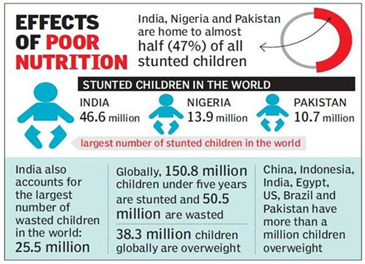

Context
Recently, UNICEF (United Nations Children's Fund), WHO (World Health Organization), World Bank Group have released a report titled- “Levels and trends in child malnutrition: Joint Child Malnutrition Estimates (JME)”, stating that in 2020, 18.7 % of Indian children were affected by ‘Wasting’ caused by poor nutrient intake.
|
What is Joint Malnutrition Estimates (JME)?
|
What is wasting?
- Wasting is defined as low weight-for-height.
- It often indicates recent and severe weight loss, although it can also persist for a long time.
- It usually occurs when a person has not had food of adequate quality and quantity and/or they have had frequent or prolonged illnesses.
- Wasting in children is associated with a higher risk of death if not treated properly.
What are the Findings of the Report?
- Wasting:
- Half of all children with wasting in the world live in India.
- In 2022, an estimated 45 million children under five (6.8 %) were affected by wasting globally, of which 13.6 million were suffering from severe wasting.
- More than three quarters of all children with severe wasting live in Asia and another 22 % live in
- Stunting:
- India had a stunting rate of 7 % in 2022, down from 41.6 % in 2012, a decade ago.
- Some 148.1 million of children under age five worldwide, were affected by stunting in 2022.
- Nearly all children affected lived in Asia (52 % of the global share) and Africa.
- Overweight:
- There are 37 million children under five who are overweight globally,an increase of nearly four million since 2000.
- India had an overweight percentage of 2.8 % in 2022, compared to 2.2 % in 2012.
- Progress:
- There is insufficient progress to reach the 2025 World Health Assembly(WHA) global nutrition targets and UN-mandated Sustainable Development Goal target 2.2.
- WHA global Nutrition Targets are:
- Reduce stunting by 40% in children under 5
- Reduce the prevalence of anaemia by 50% among women in the age group of 19-49 years
- Ensure 30% reduction in low-birth weight
- Ensure no increase in childhood overweight;
- Increase the rate of exclusive breastfeeding in the first six months up to at least 50%
- Reduce and maintain childhood wasting to less than 5%.
- Only about a third of all countries are ‘on track’ to halve the number of children affected by stunting by 2030 and assessment of progress to date not being possible for about one quarter of countries.
- Even fewer countries are expected to achieve the 2030 target of 3% prevalence for overweight, with just one in six countries currently ‘on track’.
- An assessment of progress towards the wasting target is not possible for nearly half of countries.
- WHA global Nutrition Targets are:
- There is insufficient progress to reach the 2025 World Health Assembly(WHA) global nutrition targets and UN-mandated Sustainable Development Goal target 2.2.
- India had a stunting rate of 7 % in 2022, down from 41.6 % in 2012, a decade ago.
Possible Causes:
- High levels of adult undernutrition affect one-third of the country’s adults.
- High levels of child undernutrition, affect almost every second child.
- High levels of maternal undernutrition, lead to low birth-weight.
- Inappropriate and sub-optimal infant and young child feeding and caring practices.
- Issues relating to the prevention of illnesses and access to healthcare.
- Low awareness regarding nutrition and the use of local nutritious food including sources of nutrients.
- Inadequate attention to the health and nutrition of adolescent girls.
- Inadequate access to safe drinking water and proper sanitation facilities.
What are the Recommendations?
- Children suffering from severe wasting require early detection and timely treatmentand care to survive.
- More intensive efforts are required if the world is to achieve the global targetof reducing the number of children with stunting to 89 million by 2030.
- Gaps in the available data in some regions make it challenging to accurately assess progress towards global targets. Regular data collection is therefore critical to monitor and analyze country, regional and global progress on child malnutrition moving forward.
|
About Malnutrition:
|


